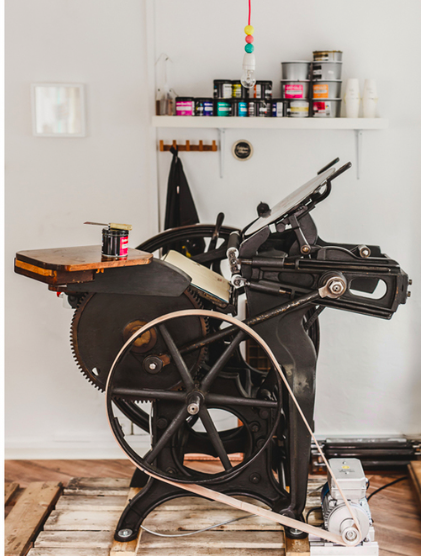
In collaboration with Poule Folle in Stuttgart (Photo: Erika Martins)
Letterpress
… is in accordance with the original printing method developed by Johannes Gutenberg. Letterpress is currently experiencing a renaissance. This is due, in the main, to the unique haptic experience created by the print process. Craftsmanship is essential for this printing method. Traditionally the printing form was merely allowed to “kiss” the paper, whereas high embossing and deep embossing define today’s approach to letterpress. Soft papers are the preferred material for letterpress.
Best possible uses of letterpress printing?
Letterpress printing is ideal for high-quality business cards, invitations and book covers. It is also frequently used for wedding cards and other greeting cards. The method is very well suited to typography, drawings and illustrations, whereas full surface coverage is difficult to print with letterpress.
What is special about letterpress printing?
You need time, craftsmanship, skill and patience for this printing method. The “press” needs to be prepared with an in-depth understanding of the machine because each setting can influence printing and therefore the print result. But it is worth the effort. The combination of top-quality materials, inks and craftsmanship is unique.
What are the advantages and the disadvantages of this technique?
The quality of letterpress printing has a price: We use high-quality papers and the production process takes time. Following the permission to print, several weeks are often necessary to complete the production process. Printing only becomes cost-effective from a print run of 50 copies, because one-off costs are significant and must not be underestimated.
Why is letterpress so popular at the moment?
Media agencies and companies attach more and more value to special products of superior quality. Letterpress also reflects the trend in society to live and consume more sustainably while print is increasingly becoming a form of experience-based communication. Letterpress is particularly popular in the USA.
How does the technique work?
In Gutenberg’s times the lead letters were set individually. Therefore, only existing typesets could be printed. Nowadays individual printing blocks can be produced with digital data. In the past, the letters were merely allowed to “kiss” the paper, whereas deep embossing is desirable nowadays.
Various machines can be used for the printing process. The traditional platen press, the manual Boston hand-operated platen press or the proofing press are the most frequently used machines.
Generally one to three different traditional letterpress inks are used per letterpress printing project. Letterpress ink is slightly translucent and not as opaque as inks used in offset printing. With letterpress printing, the paper colour is still visible and the colour of the inks is less intense.
Uncoated superfine, highly absorbent and bulky papers are best suited to letterpress printing. For a metallic or gloss effect we recommend hot foil stamping as an alternative method.
The optimum papers for letterpress printing are pure cotton papers or papers with a rag content – these papers offer the necessary bulk for engraving. The soft surface and grammages between 300 g/m2 and 900 g/m2 are ideal for letterpress printing.
Currently papers up to A3+ format can be printed. However an old Johannisberger stop-cylinder press is currently being restored in Berlin – and this press will enable letterpress print up to world format.
How did letterpress evolve?
Letterpress is the modern version of the traditional printing method invented by Johannes Gutenbeg in the 15th century. In Gutenberg’s times, however, the main driver was the multiplication of information, whereas the user experience with Print is the main focus in our times.
How do you see the future of this method?
I hope that the desire for high quality and extraordinary products is here to stay. Many people are currently willing to pay more for good quality. Compared to the USA, letterpress is still in its infancy in Germany. But I can see great potential.
Chnge is good - printed on ROUGH Warmwhite.